Invention, a Dangerous Guest — Do You Really Want Creative People in Your Organization?
I've given this talk in several versions.
This is the version given for the Indo-American Chamber of Commerce Dinner
The Briar Club, 2603 Timmons Lane, 7:00 PM, February 13, 2002
by John H. Lienhard
Mechanical Engineering Department
University of Houston
Houston, TX 77204-4792
713-743-4518
jhl [at] uh.edu (jhl[at]uh[dot]edu)
I'm certainly not the first person to worry about the uneasy peace that lies between human creativity and corporate America. But that tension needs to be looked at, and it needs to be better understood. I'd like to offer some thoughts of my own about that tension.
Whenever I think about this matter, I go back to something that happened to me twelve years ago. I dropped into a used-book store in Tillamook, Oregon, and told the proprietor man that I was scouting offbeat material for my radio program. "We don't have much here," he said, "but take a look in that big hangar just south of town."
"That big hangar" was an old quarter-mile-long WW-II garage for anti-submarine blimps. In it, people were building a machine they called a CycloCrane -- a great floating crane: half airship, half helicopter. Its body was a fat blimp rotating on a central shaft. The rotation was driven by four propellers, each mounted on a T-shaped adjustable airfoil reaching outward from the blimp's midsection -- up, down, left, and right.
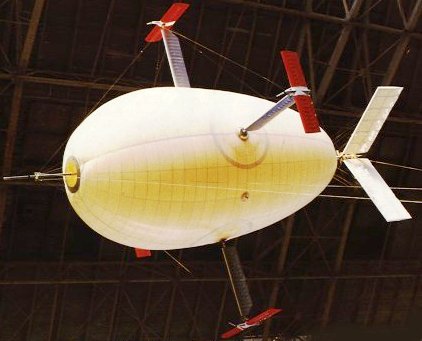
The weight and buoyancy of normal blimps have to be balanced. You can't suddenly add a big load. But the airfoils on the rotating blimp not only let the CycloCrane navigate and hover in one spot; they also overcame its huge buoyancy before it was loaded.
The CycloCrane was meant to fly into position, grasp as much as thirty-five tons of cargo, then reverse the aerodynamic forces to double the buoyancy. It was meant to take logs out of remote forests and work on large construction sites. It generally duplicated the functions of both a helicopter and a crane. It was meant to be simpler and cheaper to run than a helicopter and to carry more load.
It all made sense, but it was radical. Naturally, the work was plagued with design problems. The company was in financial trouble. Beyond that, investors never have liked new technology, because they want their money safe.
Yet, there in the Oregon woods, I'd stumbled across the old risk-taking, inventive dream that made America. I caught a glimpse of the self-expressive beauty of a new idea, and a pretty good one at that. It rode off in the air, somewhere beyond the reach of balance sheets.
But the Cyclocrane was no Romantic image of technology for me. Rather, it held all the major issues of invention and business in microcosm. And first of those issues is risk-taking.
For technology to flourish, someone has to take a chance. In the end, the CycloCrane company did fail. That old blimp hangar is now an airship museum. The CycloCrane forms one of its many exhibits. It floats there as a permanent reminder of the almost quality of so much wonderfully inventive technology.
But should it also be a grim warning to us? Don't gamble on five-legged horses? I obviously don't think so. So I begin with the first issue that comes at me out of that Tillamook blimp hanger. It is, "Why do the reckless survive?" Reckless people expose themselves to more danger. Surely that threatens their Darwinian survival. You'd expect each generation to be more careful than the last. But recklessness does survive -- generation after generation.
The hunter who won't face a buffalo starves. The parent who won't risk her life to save her child faces Darwinian extinction. Writer Melvin Konner asks us to look more closely at risk-takers. He explains that psychologists identify four faces of that person:
First: thrill and adventure-seeking
race cars and mountain-climbing.
Second: experience seeking
like travel or new friends.
Third: disinhibition
hedonism in its various forms.
Fourth: boredom susceptibility
being unable to bear routine.
That list caught me up short. For years I've praised the inventive mind. Now I had a psychological profile for recklessness, and it fit the inventive mind perfectly.
Thrill and adventure-seeking is at the heart of creativity. The "Eureka" moment is a mountain-top experience; you know that! We chance terrible frustration and defeat to get there.
Experience-seeking means opening ourselves to the dangers of change. That's the way we forge creative connections.
Creativity is certainly hedonistic. The moment of discovery is pure pleasure. Like other physical pleasures, it is a moment of letting-go -- of abandoning control.
And invention is the only real way to beat back boredom. It takes off the comfortable, protective old shoe of familiarity.
The reckless survive because invention is the primal act of human recklessness. It's also our major survival trait. Unlike bears, we can't survive the cold without heaters and houses. Unlike lions, we can't kill prey without weapons. Unlike oxen, we can't graze grass we didn't plant and harvest. Recklessness is more than entering a burning house to save our child. For our frail species it is that, but it's more. It's the courage of the creative spirit. It's the hedonistic pleasure of abandoning control. It's risking change.
We're the only species that must give its future to the fruit of its inventions. That's dangerous business. And some reckless among us do perish. But recklessness survives, just because our species depends upon it.
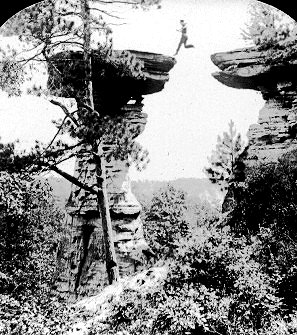
And, the matter of our species brings us to the second major theme raised by my Cyclocrane story. This theme is more subtle, and I can't put in an epigrammatic nutshell. This one is about technology and human nature -- about the peculiar nature of the human species.
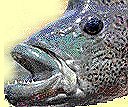 Anthropologists Malcom Smith and Robert Layton tell a strange tale about the integrity of the human race. They begin with an African lake teeming with strange fish called cichlids. Those cichlids come in two hundred different species -- all pretty similar. Only their lips, jaws, and teeth have evolved differently. Some evolved into fin-eaters -- some into worm eaters. Some cichlids eat snails. Each has evolved into a tiny niche of the ecology. That kind of subdividing is common. It's created 40,000 species of fish, birds, and mammals.
Anthropologists Malcom Smith and Robert Layton tell a strange tale about the integrity of the human race. They begin with an African lake teeming with strange fish called cichlids. Those cichlids come in two hundred different species -- all pretty similar. Only their lips, jaws, and teeth have evolved differently. Some evolved into fin-eaters -- some into worm eaters. Some cichlids eat snails. Each has evolved into a tiny niche of the ecology. That kind of subdividing is common. It's created 40,000 species of fish, birds, and mammals.
So why haven't we splintered like that? Humankind is only one species. One young hunter can chase down a rabbit. Another can spear a fish. Yet we haven't specialized into one race of rabbit-catchers and another of fish-spearers. Why are we alike in all but the most minor features, things like skin color and hair diameter?
We're not like the fish in that African lake. We've faced every environment on Earth. We've had every chance to divide into specialized subspecies. But we have one key attribute. Humans share! We share in complex ways no other animal does. Back in camp, the rabbit-chaser and the fish-spearer exchange food. We've done that as long as we've existed. Of course it helps that we're very omnivorous. We eat almost anything. If it lives, we've eaten it at one time or another. More importantly, we've also shared it.
Then there's the most important dimension of sharing of all. We share the techniques for gathering food and fulfilling other needs. One cichlid fish had to develop its own specialized jaw for crushing and eating snails. We share our knowledge of snail-catching, of rabbit-chasing, or of fish-spearing.
That's what technology is. It's the lore, the -ology, the science -- of techni. Technology is our primary act of sharing. Technology shapes us into one body instead of a thousand subspecies. We're bound in a unique and instinctive tether of generosity, with our technologies right at the core of that generosity.
Let me offer an example of this kind of technological existence at its best. Do you know the word baidarka? A baidarka is an Alaskan Aleut kayak. It's light enough that a child can carry it. It'll capsize if you put it in the water without a passenger. It's a whalebone and driftwood frame covered with seal skin. You have to be a gymnast to get into one. But, once in, you can skim the water at ten knots. You can land a seal; some Aleuts have even landed whales.
Baidarkas come in all sizes and many shapes. We have records of baidarkas over the past 260 years, and what they show is that the Aleuts have constantly changed and evolved them. They were not at all conservative about engineering design. A museum curator in Anchorage told me, "The Aleuts were born gadgeteers!"
Aleut navigators rode their baidarkas far out to sea -- to California, to the warm Pacific. Aleut legend tells how we know the earth is round. They once sent young men out in two baidarkas. They came back old, without ever having found any edge.
Aleut baidarkas are so varied in shape and form that they've been defined as merely "a frame of mind." And those exquisite buoyant forms make me think of something the great Russian Orthodox missionary Ivan Veniaminov said. He recounted the Aleut ritual of rising in the morning. One must stand, he said, naked,
face to the East, and opening the mouth inhale the light and the air, [and cry] I do not sleep. I am alive. I face you, the life-giving light, and will always live with you.
For me, the baidarka is are more than just a boat. It's an icon of the generous, risk-taking mentality of a people who live on the edge of survival. It is a way of life and light and buoyancy of the spirit.
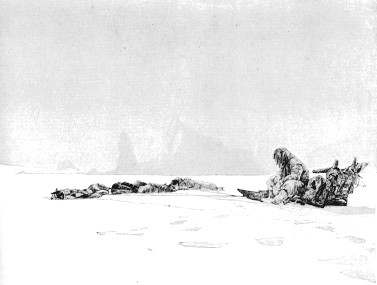
So two themes that define our species are sharing, of which technology is the great manifestation, and risk-taking, of which invention is the great manifestation. I see those two themes in that Tillamook blimp hangar and in the Aleut kayak.
And they reveal yet another powerful theme: Invention is also self-expression. The CycloCrane and the baidarka are remarkable instances of self-expression. But it suits my case to offer you a more modest example: Five years ago, a friend -- a linguist by training -- stopped me. "John," he said, "let me show you something." It was a circular slide rule he'd made twenty years earlier -- actually, just before we all had pocket calculators.
He'd solved a grocery-store pricing problem. Suppose a nine-ounce bottle of hair shampoo costs $1.70, and a thirteen-ounce bottle costs $2.85. Which is the better buy? With his slide rule, you could calculate the first unit price, 19 cents an ounce, and then place a marker. When you calculate the second unit price of 22 cents, the device compares the two numbers. You can see which is cheaper. He'd created a slide rule with one memory unit. The motive wasn't profit or a patent. Once he'd worked it out, he was done. It was creative fun. It was also very clever.
That kind of self-expressive invention goes on all around us -- far more than people freely admit. We talk too much about famous inventors. Watt, Edison, and Bell invented much, and they invented well. But it took far more than they gave us to shape the world we live in.
Creativity -- your creativity -- is omni-present. It is the structural glue that makes the world run. Take stock of it in your life. A colleague invents new means for moving roofing materials to the top of a building or new software for scheduling work. Your daughter invents new means for storing botanical specimens for her high-school project. You solve the problem of making a back-yard hose serve both to water the lawn and to keep the dog-dish filled.
It's all such seemingly small stuff, you don't even think of it as invention. But creative self-expression it is. And it's in your bones; don't ever doubt that. Invention is not reserved for a unique breed of people at all. Rather it's what we must all manage to do, every day, if we mean to be fully functional citizens -- if we hope to survive. Invention is there every time you look closely at the person next to you -- or in the mirror! That slide rule wasn't wonderful for its uniqueness but rather for symbolizing what we're all capable of.
If my linguist friend can invent a slide rule, I can invent a word. I'll invent the word panvention -- a noun made by combining the Greek term pan, which means "all" of us, with the familiar word invention. Panvention is the ever-present process of invention as it occurs in all walks of life and is practiced by all people. Panvention is essential to every level of human improvement. Panvention is what you are all about, and every one of you has done far more of it than you even remember.
Now, another theme lurked in that Tillamook hangar twelve years ago. It was the fact that no one really knew what they had there. What would this huge helium-filled beast be when they finished it? For more on this question I turn to Edward Tenner's book, Why Things Bite Back. The book is subtitled, Technology and the Revenge of Unintended Consequences. And that, in a nutshell, is Tenner's message. When we invent new technologies, things do bite back.
A new safety device lulls us into carelessness and increases accidents. Pesticides and germicides breed new and tougher insects and diseases. Tenner's idea isn't new, but he does a fine job of rearticulating it. Tenner's term, Revenge Effect, summons up the way in which, when we mess with the natural order of things, things bite back. And invention is always a matter of messing with the natural order of things.
He takes care not to be simplistic. New technologies certainly improve the quality of life. Medical procedures have reduced the time we spend in hospitals and hastened recoveries. Yet the number of procedures and medications a patient undergoes has risen astronomically.
We suffer so many revenge effects in medicine because the human system is terribly complex and still poorly understood. Two hospital procedures combine to produce effects that wouldn't be produced by either one alone. Three or more procedures can lay impossible demands on any doctor's knowledge of side effects.
The same thing applies in the engineering systems that so many of you deal with. As they grow more complex, they harbor more trouble. And complex devices that interact with our human system always produce revenge effects. Tenner talks about the computer -- the way they've made work routines less straightforward than they were when we just handled paper. We lose enormous amounts of time and money learning software that never stands the test of time. Meanwhile, eyestrain, neck strain, and carpal tunnel syndrome all increase.
So, does that mean we should reject new medicine? Does it mean we should turn away from computers? Hardly! The point I've been making here is that new technology is bred in our bones. The day we quit pioneering, we quit being human.
The answer is as subtle as the problem itself. Nature demands a wearing-in process. We have to be alert to early warnings and be ready to back off. Wanting too much is what causes us to ignore those warnings and react too slowly. And every time we fail to listen, nature forcefully gets our attention.
One last look back inside that CycloCrane hangar in Tillamook, Oregon. One last question: Who begat this thing, anyway? Who is the mother of invention? There are so many candidates. Yet people always want to begin their lists with necessity and gain. Of course, invention serves necessity. But do you really believe necessity can drive the inventive muse? I have the same problem with profit. Invention can gain money for an inventor, but when has a craving for gain ever opened anyone's mind? You can't really take necessity or money seriously as parents of invention.
Let's muddy the water and ask, "Who's the father of invention?" At the risk of gender stereotyping, I'll ask, "If mother nurtures and sustains invention, who's the seminal initiator?"
Well, I'll claim flatly that freedom is the nurturing mother of invention. Invention always flourishes when people are free -- when they enjoy intellectual permissiveness. But the primal, driving, seminal, origin of invention has to be pleasure. Who doesn't crave, just once in a life crowded with pain, problems, and incompleteness, to shout, "Eureka!"? We know in our bones why Archimedes leapt from the bath and ran naked in the street, shouting: "I've found it! I've found it!" That is Konner's reckless hedonism. If we've once tasted the pleasure of creating something good and new, we'll return to that moment at all costs. The only way to walk away from such pleasure, once we've known it, is to let something die inside us. Some inventors have done that -- invented one thing and then lived off the profits. But not the good ones. They keep coming back to that well of life until the day they die.
Now, is this picture of invention anything you want in a smooth-running, profit-based organization? I've described a dangerous biological necessity, one that drives us to excess, one that brings trouble into the organization and into our lives. Yet I've also described a process that we must embrace if we hope to be complete human beings -- one no organization can live without. The persistent substitution of the gentler word innovation, for the hard word invention, reflects our craving to evade the problem.
So I'll finish with something that happened when I gave a talk in Philadelphia, years ago. I remember sitting on the plane back to Houston, trying to sort it out. I'd talked about inventiveness. I'd talked about the way strange stories follow creative people around, because invention itself parts company with normality.
I'd mentioned the way Einstein used the same soap for washing and shaving -- how he figured anything more would've complicated his life unbearably.
I'd told them about Norbert Wiener, the father of cybernetics -- how he came home from his office at MIT one evening. He got off the bus in his neighborhood. Wiener never had learned to drive a car. He wandered down his street in a brown study, thinking equations. Suddenly he stopped by a little girl playing marbles. He asked, "Little girl, could you tell me which is the Wieners' house?"
The little girl smiled and said, "Oh, daddy, we live right across the street."
I'd told the group that invention is revolution. I'd said that, since invention is a trip into an uncharted land, it has to be eccentricity. It can be no other.
Afterward, during questions and answers, a young man asked, "Do you mean I can't be inventive and still live a normal life?" It was an ingenuous question, but I couldn't take it lightly. It was one of those questions people ask when they aren't looking for information. This fellow saw the issues with perfect clarity. I knew in my bones that he'd voiced the question because he hoped he could get a new answer. He was like the person who goes back again and again to the opera hoping that, just once, Don Jose will have the sense to walk away from Carmen.
His question was difficult and dangerous. He so clearly wanted to be let off the hook. He wanted the brass ring without having to reach out into space to get it. He didn't want to risk humiliation. He didn't want to step into the void. I took a deep breath and answered. I said, You cannot be inventive and live a normal life.
Oh, I knew you can live a normal life, at least in the outward markers of normalcy. But at some point you have to go where others have not gone. Perhaps the Romantic poet Coleridge best answers the young man's question. Coleridge ended his poem Kubla Kahn abruptly. He suddenly broke off, and, in one last verse, he told his vision of the Creative Hero emerging out of his own tormented dreams. Coleridge wrote,
I would build a dome in air,
And all should cry, Beware! Beware!
His flashing eyes, his floating hair.
Weave a circle round him thrice,
And close your eyes with holy dread,
For he on honeydew hath fed,
And drunk the milk of paradise.
That man in the audience saw what others didn't. He knew why he should "close his eyes with holy dread" at the idea of drinking the creative milk of paradise. He knew what the inventive genie could do for him once it got out of the bottle. But he'd also caught a glimpse of the size and power of the beast. He asked the question again on the way out of the building. He knew what was at stake. It bothered him.
By then it was I who was really bothered. He reminded me that creativity is too large a thing to advocate lightly. Without creativity we're nothing. But when we step off onto those unexpected side roads that intersect the main arteries of our thinking, we are not welcome. Change threatens the world around us.
If we function creatively, people will certainly try to "weave a circle round [you] thrice." The creative daemon within us poses a threat that most people want to see sealed off. We all want the fruits of invention, but who in his right mind wants to deal with invention? Yet, one way or another, that's the price we pay, not only for progress, but for being human. That contradiction is the essential problem that the business world is struggling to deal with.
If you and I really want to embrace invention, and to reap its benefits, then we must be prepared to fully embrace five things. The first four look easy, although they aren't really:
Risk, Sharing, Freedom, and Pleasure
But the fifth is unavoidable, and we'd better be ready to live with it as well. The fifth is
Fear.
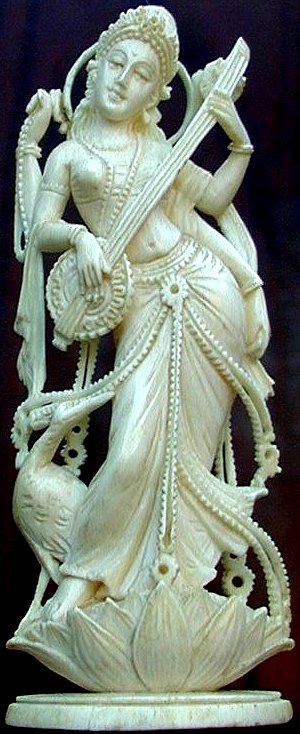
Sarasvati, Goddess of learning and all the creative arts
(Photo by John Lienhard. Image provided by Balraj Sehgal)
SOME SOURCES
Archbold, R., Hindenburg: An Illustrated History. Toronto, Ontaria: Madison Press Books, 1994, pp. 214-217.
The CycloCrane was built by: AeroLift Inc., 4105 Blimp Blvd., Tillamook, Oregon 97141. It's engineering office was in California: AeroLift Inc., 17316 Edwards Road, Cerritos, CA 90701. The inventors of the CycloCrane were Arthur J. Crimmins and Donald J. Doolittle.
Konner, M,, Why the Reckless Survive, and Other Secrets of Nature. New York: Penguin Books, 1991, pp. 125-139.
Smith, M. T. and Layton, R., "On Human Nature." The Sciences. New York: The New York Academy of Sciences, January/February 1989, pp. 10-12.
Dyson, G., Baidarka: The Kayak. Anchorage: Alaska Northwest Books, 1986.
Veniaminov, I., Notes on the Islands of the Unalaska District, (L. T. Black and R. H. Geoghegan, tr.; R. A. Pierce, ed.). Kingston, Ont.: The Limestone Press, 1984. (This includes much Aleut technology including the baidarka.)
The linguist who built the pricing slide rule was University of Houston Librarian Dr. John E. "Jeff" Fadell.
Tenner E., Why Things Bite Back: Technology and the Revenge of Unintended Consequences. New York: Alfred A. Knopf, 1996.